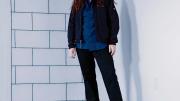Though she’s been called a conceptual artist, “That’s just for lack of a better term,” says Annette Lemieux, professor of the practice of studio arts in the department of visual and environmental studies. Maybe “mixed-media artist” comes closer; think Robert Rauschenberg. Lemieux’s pieces range from Two Vistas, a 17-by-67-foot mural of clouds, to Hey Joe, eight wooden charger rifles grouped in a vertical bouquet with pink carnations stuck in their barrels. Her works tend to be life-sized, like The Great Outdoors (1989), an old black-and-white postcard enlarged into a background vista for an actual Adirondack chair, table, and lamp. “I want to break down the barrier between the viewer and the work, and take you to the actual space and time of the piece,” she explains. “I’m not interested in illusions.” Her family of origin is both Roman Catholic and military; early on, she used icons like crosses and flags “to create a dialogue with the audience.” Trained as a painter at Hartford Arts School (B.A., 1980), she worked in New York for a decade, taught at Brown, then came to Harvard in 1996. Husband Erik manages business authors, and Lemieux gardens at their Brookline home. After 9/11, she temporarily turned away from political pieces like Stampede, a riff on Nazi goose-stepping, to “comfort art,” including a 64-inch pillow. (“I am 64 inches,” she explains.) Her studio courses include “Building Thought” and “Post Brush,” whose students, unexpectedly, moved beyond works on paper to mixed media. “You can do anything possible, as long as it’s good,” Lemieux says. “You can’t stop an idea.”
Harvard Portrait: Annette Lemieux
Harvard Portrait: Annette Lemieux
Though she’s been called a conceptual artist, “That’s just for lack of a better term,” says Annette Lemieux, professor...

Annette Lemieux
Photograph by Tracy Powell
Explore More From Current Issue

For Campus Speech, Civility is a Cultural Practice
A former Harvard College dean reviews Princeton President Christopher Eisgruber’s book Terms of Respect.

A Forgotten Harvard Anthem
Published the year the Titanic sank, “Harvard’s Best” is a quizzical ode to the University.

Mount Vernon, Historic Preservation, and American Politics
Anne Neal Petri promotes George Washington and historic literacy.


